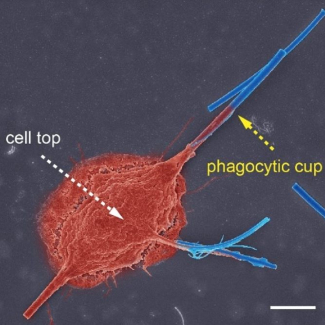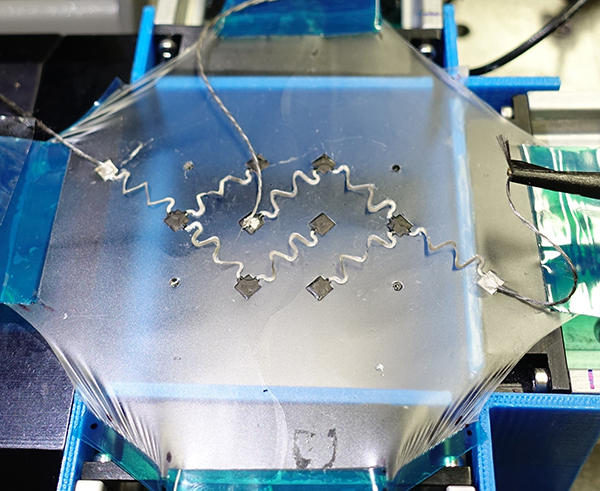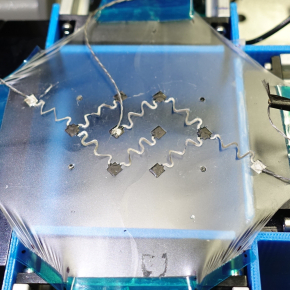
Portable electronics: a stretchable and flexible biofuel cell that runs on sweat
A unique new flexible and stretchable device, worn against the skin and capable of producing electrical energy by transforming the compounds present in sweat, was recently developed and patented by CNRS researchers from l’Université Grenoble Alpes and UC San Diego (USA). This cell is already capable of continuously lighting an LED, opening new avenues for the development of wearable electronics powered by autonomous and environmentally friendly biodevices. This research was published in Advanced Functional Materials on September 25, 2019.
The potential uses for wearable electronic devices continue to increase, especially for medical and athletic monitoring. Such devices require the development of a reliable and efficient energy source that can easily be integrated into the human body. Using “biofuels” present in human organic liquids has long been a promising avenue.
Scientists from the Département de chimie moléculaire (CNRS/Université Grenoble Alpes), who specialize in bioelectrochemistry, decided to collaborate with an American team from UC San Diego, who are experts in nanomachines, biosensors, and nanobioelectronics. Together they developed a flexible conductive material consisting of carbon nanotubes, crosslinked polymers, and enzymes joined by stretchable connectors that are directly printed onto the material through screen-printing1
.
The biofuel cell, which follows deformations in the skin, produces electrical energy through the reduction of oxygen and the oxidation of the lactate present in perspiration. Once applied to the arm, it uses a voltage booster to continuously power an LED. It is relatively simple and inexpensive to produce, with the primary cost being the production of the enzymes that transform the compounds found in sweat. The researchers are now seeking to amplify the voltage provided by the biofuel cell in order to power larger portable devices.


- 1Brevets : - F. Giroud, A. J. Gross, S. Cosnier. Bioelectrode for the detection and/or oxidation of glucose and its manufacturing process and device comprising it. French patent n° 1662997 submitted December 21, 2016 . Published 22 June 2018. Extension PCT n°PCT/FR2017053689 submitted December 21, 2017. Published PCT n° WO2018115710A1 28 June 2018.. Applicants: CNRS - S. Cosnier, R. Haddad. Electrochemical reactor block. French patent n° 1559069 submitted September 25, 2015 ; n°3041819. Published March 31, 2017. Extension Europe, USA, Japan n°16777723.4 ; FR20160552310 ; submitted September 14, 2016.. Applicants: Université Joseph Fourier and CNRS
Stretchable and Flexible Buckypaper-Based Lactate Biofuel Cell for Wearable Electronics. Xiaohong Chen, Lu Yin, Jian Lv, Andrew J. Gross, Minh Le, Nathaniel Georg Gutierrez, Yang Li, Itthipon Jeerapan, Fabien Giroud, Anastasiia Berezovska, Rachel K. O’Reilly, Sheng Xu, Serge Cosnier, and Joseph Wang. Advanced Functional Materials, le 25 septembre 2019. DOI : https://doi.org/10.1002/adfm.201905785

